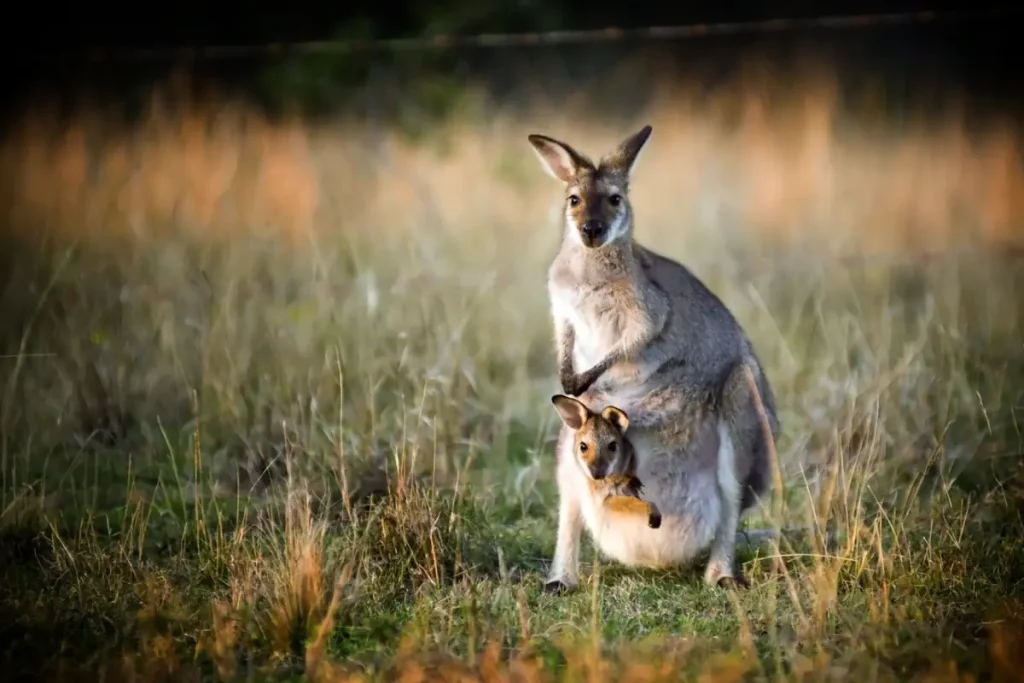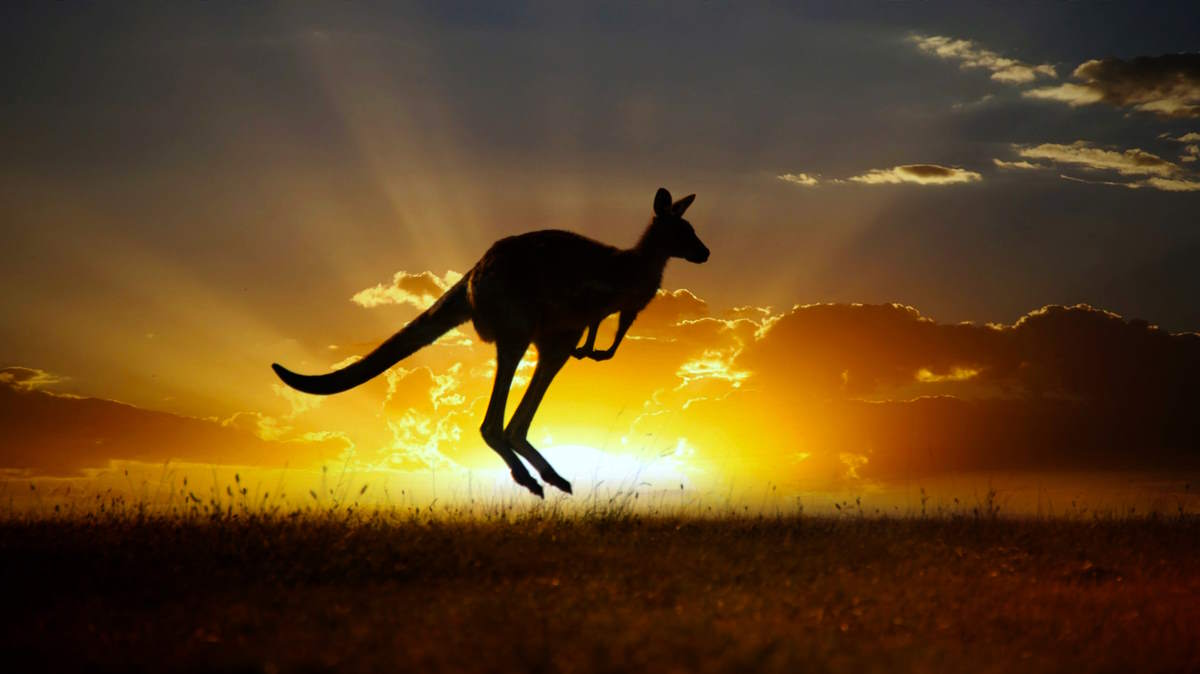Kangaroo is an iconic marsupial that is indigenous to Australia and New Guinea. Marsupials are mammals that carry their young in a pouch. Here are 10 amazing kangaroo facts.
1. Kangaroos are the largest marsupials on Earth
Although they come in different sizes, kangaroos are the largest marsupials on Earth. Large individuals can stand more than 2 meters (6 feet and 7 inches) tall and weigh 90 kg (200 lb).

2. They move by hopping
Kangaroos move by hopping. They are the only large animals in the world that use hopping as a means of locomotion.
The comfortable hopping speed is about 25 km/h (15.5 mph), but thanks to their large feet and very powerful hind legs, they have a sprinting speed of up to 56 km/h (35 mph) for short bursts. They can also cover up to 8 meters (25 feet) in a single hop.
Furthermore, kangaroo hopping is the most energy-efficient form of unassisted, bipedal land travel yet observed.
3. They use their huge tail as a third leg
The tails are one of the most distinctive features of these iconic Australian marsupials. The tail of a kangaroo is long and muscular and can measure up to three times the length of the kangaroo’s body: it can be as long as 1 meter (3.3 feet).
The tail serves several important functions: First, it helps the kangaroo maintain balance while hopping, acting as a counterbalance to the animal’s body. The tail can also be used as a powerful weapon if the animal is threatened, as it can be whipped around to deliver a strong blow to an attacker.
While fighting, they balance themselves on their huge tails and kick each other in the abdomen. Their kick is extremely powerful and dangerous. They can easily injure a human by kicking.
In addition to its physical functions, the tail is also an important source of fat storage. They are adapted to living in a harsh, arid environment, and the ability to store fat in their tails allows them to survive for long periods of time without access to food or water.
Also, when moving slowly, sometimes they do not hop and instead, use their tail as a third leg.
4. They are good swimmers
Kangaroos are surprisingly good swimmers. Their massive and strong tail once again helps them here. When threatened by a predator like a dingo, they usually flee toward the water, if any body of water is around.
Furthermore, sometimes, once the kangaroo is chest-deep in the water, it turns around and confronts the predator, grabs it with its forelimbs, and attempts to drown it!
5. There are more kangaroos than humans in Australia
Their lifespan is short: they live around 6 years in the wild. Captive individuals tend to live longer (up to 20 years), like most wild animals.
The reason their population is so high is that females are almost constantly pregnant. And the gestation period is incredibly short: only 33 days.
As a result of this (and the fact that they have few predators), there are more kangaroos than humans in Australia! As of 2015, there were 44 million kangaroos in Australia. For comparison, there are about 24 million people living on the continent.

6. Newborn babies can’t suckle
Newborn kangaroos can’t suckle or swallow, so mothers use their muscles to pump milk down the baby’s throat.
Baby kangaroos are known as joeys. Females are called a doe and males are called a buck.
Another amazing fact about kangaroos is: The mother can freeze the embryo development until the current joey is able to leave the pouch! Once it leaves, she resumes her pregnancy.

7. They are mostly left-handed
They use their hands while feeding and grooming. Researchers observed that a whopping 95% of individuals are left-handed. This observation challenges the idea that handedness is unique to primates.
8. Kangaroos don’t emit methane
All kangaroo species are strict herbivores. The eastern grey kangaroo usually eats grass. Red kangaroos also eat grass but they include significant amounts of shrubs in their diets. Smaller species also consume hypogeal fungi.
Scientists have identified a special type of bacterium in their stomach that processes food without producing methane. Unlike other herbivores such as cattle, they release virtually no methane in the atmosphere. It’s not only more efficient for them to process their food but also good for the environment since methane is a powerful greenhouse gas with a global warming potential of about 28-34 times that of CO2.
Researchers hope to study these bacteria to try to implement them in farm animals like cows in order to reduce the amount of methane released by them.
9. There’s a species of kangaroo that lives in trees
You wouldn’t think they were kangaroos if you saw them! They are small, and they look like a monkey mixed with a sloth mixed with a bear.
They usually walk on four legs and do not hop much.
The tree Kangaroos are native to New Guinea. In Australia, they can be found only in far northeastern Queensland.
Unfortunately, their populations are in decline due to deforestation and hunting.
10. They do “boxing”
Fighting or “boxing” is common in all species of kangaroos, usually between males. Fights can be brief or long and ritualized. In highly competitive situations such as males fighting for access to
Smaller males fight more often near females in oestrus, while the large males in consorts do not seem to get involved. Ritualized fights can arise suddenly when males are grazing together. However, most fights are preceded by two males scratching and grooming each other. One or both of them will adopt a high-standing posture, with one male issuing a challenge by grasping the other male’s neck with his forepaw.
Sometimes, the challenge will be declined. Interestingly, large males often reject challenges by smaller males – not a common behavior in animals, usually, larger males use the advantage of being much more powerful in the other animal species. During the fight, the combatants adopt a high-standing posture and paw at each other’s heads, shoulders, and chests.
They will also lock their forearms and wrestle and push each other as well as balance on their tails to kick each other in the abdomens. Brief fights are similar except there is no forearm locking. The losing combatant seems to use kicking more often, perhaps to parry the thrusts of the eventual winner.
Winners are decided when an individual breaks off the fight and retreats. Winners are able to push their opponents backward or down to the ground. They also seem to grasp their opponents when they break contact and push them away.
The initiators of the fights are usually the winners. These fights may serve to establish hierarchies based on dominance among males, as winners of fights have been seen to displace their opponents from resting sites later in the day. Dominant males may also pull grass to intimidate subordinates.
Notes
- A wallaby is a small to medium-sized marsupial belonging to the same family as kangaroos. Wallabies are found primarily in Australia and nearby islands, and there are several different species of wallabies, each with its own unique characteristics. Like kangaroos, wallabies have powerful hind legs and a tail that helps them balance while hopping. They are herbivores and primarily feed on grasses and other vegetation. Unlike their larger cousins, however, wallabies are generally smaller in size and often have a more compact build. They also tend to live in smaller groups or as solitary animals, whereas kangaroos often live in larger groups known as “mobs.”
Sources
- Kangaroo on Wikipedia
- 10 Incredible Facts About Kangaroos on the Tree Hugger website
- Cover image: Deposit Photos
- Space Shuttle Endeavour’s Touchdown Meets Columbia’s Salute [An amazing photo from the past] - February 29, 2024
- Moon Landings: All-Time List [1966-2024] - February 23, 2024
- From Orbit to Ordinary: 10 Earthly Applications of Space Technology - January 23, 2024

